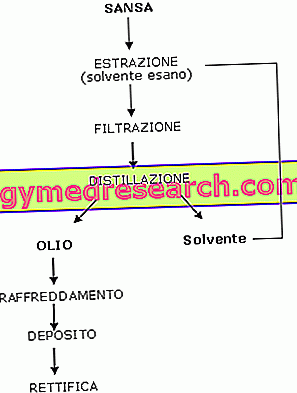Introduction: olive oil
Olive tree: botanical aspects and cultivation
Mature olive composition, nutritional properties
Olive harvest
Olive oil: chemical composition
Olive oil: properties and nutritional characteristics
Preparation of olive oil
Olive oil conservation
Pomace oil
Classification of olive oils, analysis and fraud
Olive oil as a laxative
Olive in herbal medicine - sea buckthorn
Cosmetic use: olive oil - Unsaponifiable with olive oil - Olive leaf extract
Pomace oil
OLIVE GRILLED OIL: oil obtained from the cutting of refined olive-pomace oil and virgin olive oil different from the lampante; acidity not higher than 1%.
The pomace is the solid residue that remains after extracting the oil. From the pomace it is possible to extract modest quantities of oil (3-6% by weight) by pressing or by centrifugation. The resulting oil is called crude olive-pomace oil and is not edible. Through a refining process this oil is purified to obtain a refined pomace oil with an acidity of no more than 0.5%.
The pomace oil ready for use is obtained by mixing the refined pomace oil with virgin olive oils other than lamp oil, with an acidity of no more than 1.5%. There is no minimum amount of virgin oils to add.
The pomace oil composition is similar to that of olive oil compared to which it is richer in linoleic acid (9.5-15.5%) and elaidinic acid (0.2%), a trans isomer of oleic acid also contained in butter and margarine. For this reason too, pomace oil is a much poorer and less beneficial oil than olive oil.
Oil extraction from pomace

Of a consistency similar to a paste, the pomace still contains a certain percentage of oil, which however can no longer be extracted simply by pressing. The quantity of residual oil varies from 4.5 to 9% if it comes from discontinuous plants, from 2.5 to 4.5% if it comes from new generation continuous plants.
The only way to extract this not insignificant amount of oil is to use chemical means. The pomace is mixed with a selective solvent for the lipid component, called hexane, which solubilizes the residual oil. A filtration follows, which allows to obtain on one side the exhausted pomace, and on the other a solution of oil in hexane. To remove the latter a distillation process takes place. The recovered hexane can be reused to extract the oil from new pomace (it acts as a technological adjuvant).
The time between the extraction of olive oil with physical means and the processing of residual pomace with chemical solvents must be as short as possible.
The composition of the pomace oil is similar to that of olive oil; the percentage of linoleic acid increases (9.5 - 15.5%) and elaidic acid (trans isomer of oleic acid) is present in quantities lower than 0.2%. The formation of these trans acids is due to the grinding processes during which heat is also used.



